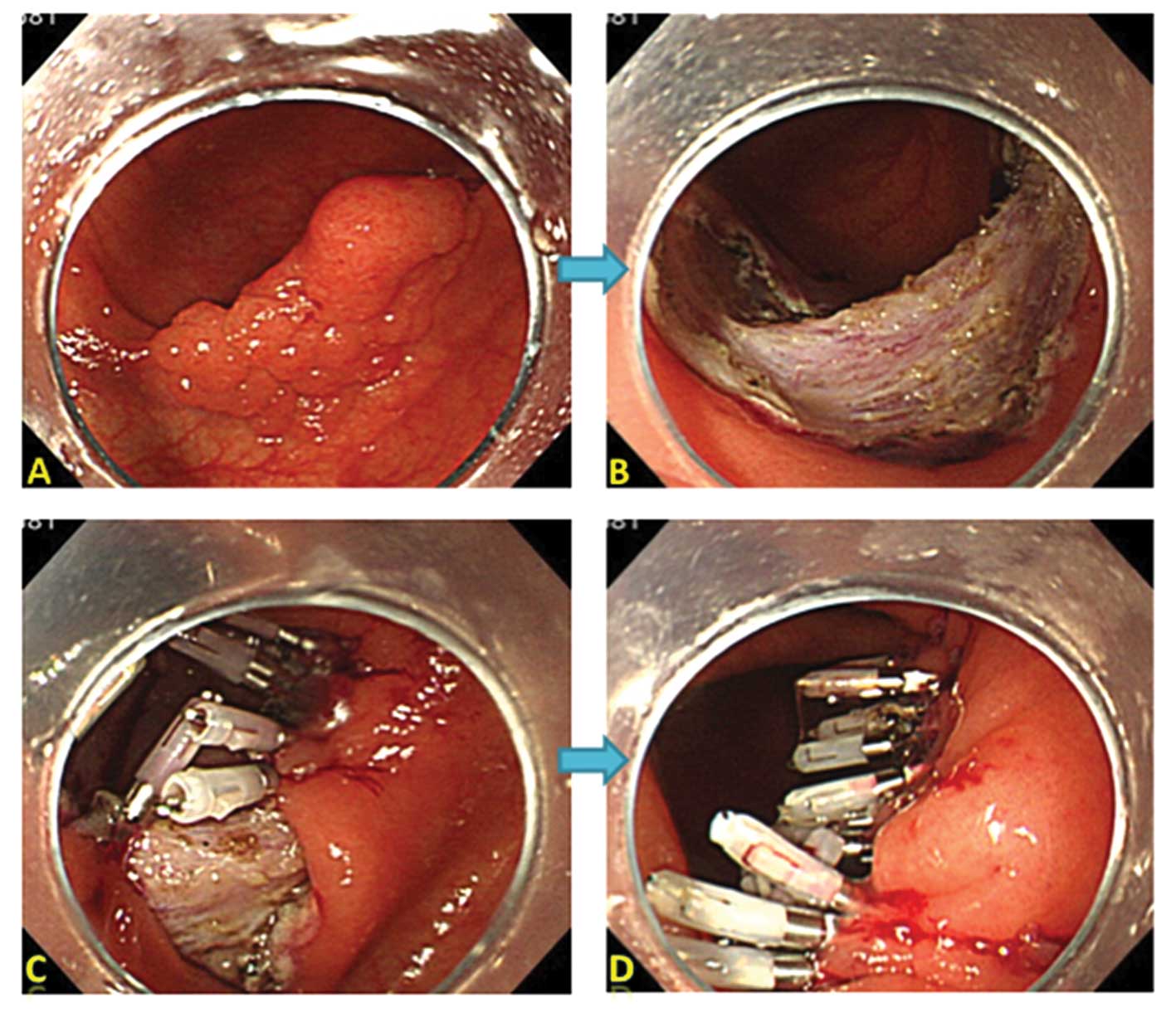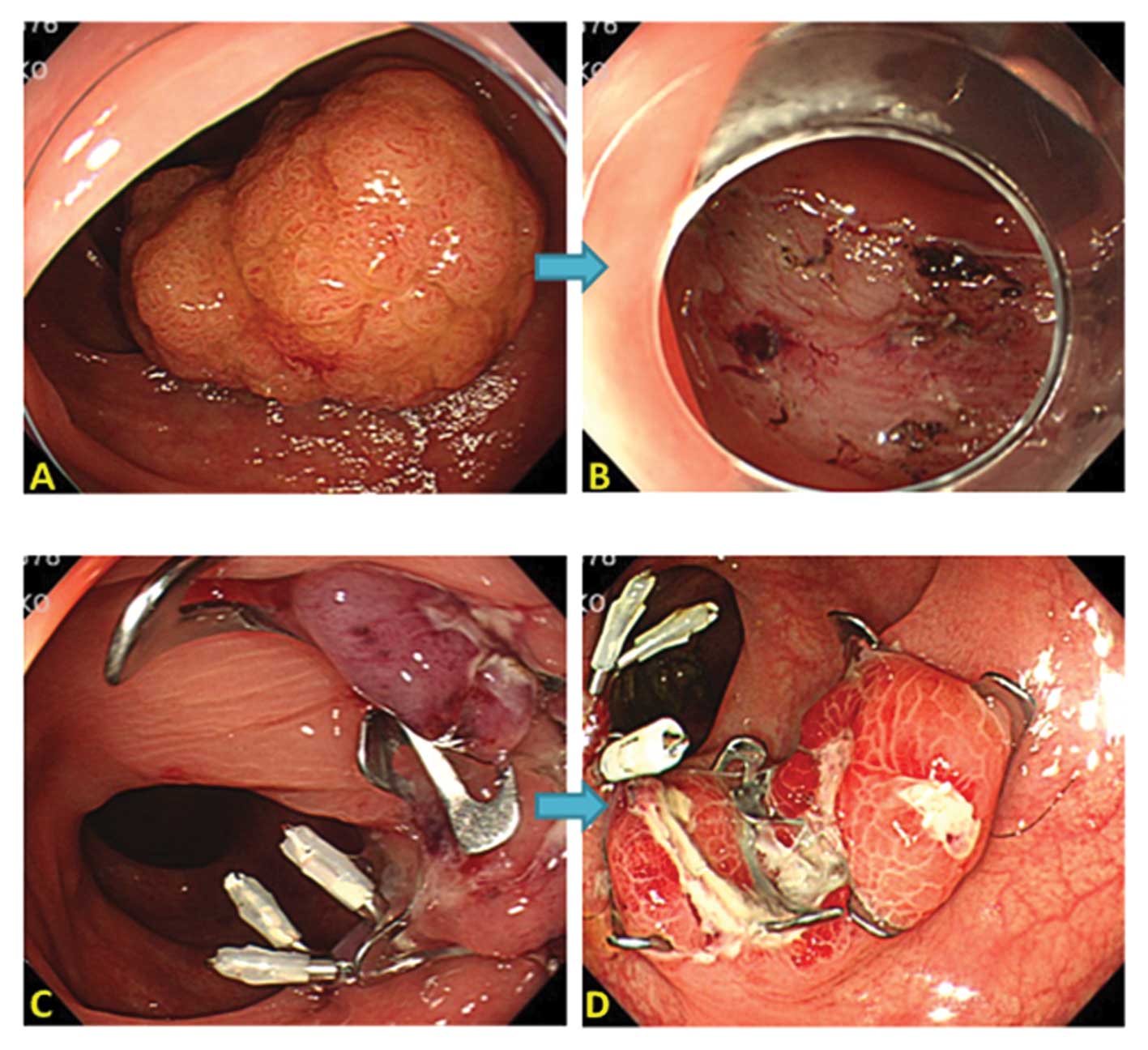|
1
|
Hurlstone DP, Sanders DS, Cross SS, et al:
Colonoscopic resection of lateral spreading tumours: a prospective
analysis of endoscopic mucosal resection. Gut. 53:1334–1339. 2004.
View Article : Google Scholar : PubMed/NCBI
|
|
2
|
Yoshida N, Yagi N, Naito Y, et al: Safe
procedure in endoscopic submucosal dissection for colorectal tumors
focused on preventing complications. World J Gastroenterol.
16:1688–1695. 2010. View Article : Google Scholar : PubMed/NCBI
|
|
3
|
Raju GS, Saito Y, Matsuda T, et al:
Endoscopic management of colonoscopic perforations. Gastrointest
Endosc. 74:1380–1388. 2011. View Article : Google Scholar : PubMed/NCBI
|
|
4
|
Fujishiro M, Yahagi N, Kakushima N, et al:
Outcomes of endoscopic submucosal dissection for colorectal
epithelial neoplasms in 200 consecutive cases. Clin Gastroenterol
Hepatol. 5:678–683. 2007. View Article : Google Scholar : PubMed/NCBI
|
|
5
|
Isomoto H, Nishiyama H, Yamaguchi N, et
al: Clinicopathological factors associated with clinical outcomes
of endoscopic submucosal dissection for colorectal epithelial
neoplasms. Endoscopy. 41:679–683. 2009. View Article : Google Scholar
|
|
6
|
Anderson ML, Pasha TM and Leighton JA:
Endoscopic perforation of the colon: lessons from a 10-year study.
Am J Gastroenterol. 95:3418–3422. 2000.PubMed/NCBI
|
|
7
|
Onogi F, Araki H, Ibuka T, et al:
‘Transmural air leak’: a computed tomographic finding following
endoscopic submucosal dissection of gastric tumors. Endoscopy.
42:441–447. 2010.
|
|
8
|
Yoshida N, Kanemasa K, Sakai K, et al:
Experience of endoscopic submucosal dissection (ESD) to colorectal
tumor-especially about clinical course of cases with perforation
(Japanese literature with English abstract). Gastroenterol Endosc.
50:1472–1483. 2008.
|
|
9
|
Kashida H and Kudo SE: Early colorectal
cancer: concept, diagnosis, and management. Int J Clin Oncol.
11:1–8. 2006. View Article : Google Scholar
|
|
10
|
Saito Y, Fujii T, Kondo H, et al:
Endoscopic treatment for laterally spreading tumors in the colon.
Endoscopy. 33:682–686. 2001. View Article : Google Scholar : PubMed/NCBI
|
|
11
|
Tanaka S, Haruma K, Oka S, et al:
Clinicopathologic features and endoscopic treatment of
superficially spreading colorectal neoplasms larger than 20 mm.
Gastrointest Endosc. 54:62–66. 2001. View Article : Google Scholar : PubMed/NCBI
|
|
12
|
Uraoka T, Saito Y, Matsuda T, et al:
Endoscopic indications for endoscopic mucosal resection of
laterally spreading tumors in the colorectum. Gut. 55:1592–1597.
2006. View Article : Google Scholar : PubMed/NCBI
|
|
13
|
Saito Y, Uraoka T, Matsuda T, et al:
Endoscopic treatment of large superficial colorectal tumors: a case
series of 200 endoscopic submucosal dissections (with video).
Gastrointest Endosc. 66:966–973. 2007. View Article : Google Scholar : PubMed/NCBI
|
|
14
|
Ishiguro A, Uno Y, Ishiguro Y, et al:
Correlation of lifting versus non-lifting and microscopic depth of
invasion in early colorectal cancer. Gastrointest Endosc.
50:329–333. 1999. View Article : Google Scholar : PubMed/NCBI
|
|
15
|
Kobayashi N, Saito Y, Sano Y, et al:
Determining the treatment strategy for colorectal neoplastic
lesions: endoscopic assessment or the non-lifting sign for
diagnosing invasion depth? Endoscopy. 39:701–705. 2007. View Article : Google Scholar
|
|
16
|
Participants in the Paris workshop. The
Paris endoscopic classification of superficial neoplastic lesions:
esophagus, stomach, and colon: November 30 to December 1, 2002.
Gastrointest Endosc. 58:S3–S43. 2003. View Article : Google Scholar : PubMed/NCBI
|
|
17
|
Kudo S, Lambert R, Allen IJ, et al:
Nonpolypoid neoplastic lesions of the colorectal mucosa.
Gastrointest Endosc. 68:S3–S47. 2008. View Article : Google Scholar : PubMed/NCBI
|
|
18
|
Schlemper RJ, Riddell RH, Kato Y, et al:
The Vienna classification of gastrointestinal epithelial neoplasia.
Gut. 47:251–255. 2000. View Article : Google Scholar : PubMed/NCBI
|
|
19
|
Dixon MF: Gastrointestinal epithelial
neoplasia: Vienna revisited. Gut. 51:130–131. 2002. View Article : Google Scholar : PubMed/NCBI
|
|
20
|
Waye JD: The postpolypectomy coagulation
syndrome. Gastro-intest Endosc. 27:1841981. View Article : Google Scholar
|
|
21
|
Waye JD, Lewis BS and Yessayan S:
Colonoscopy: a prospective report of complications. J Clin
Gastroenterol. 15:347–351. 1992. View Article : Google Scholar : PubMed/NCBI
|
|
22
|
Waye JD, Kahn O and Auerbach ME:
Complications of colonoscopy and flexible sigmoidoscopy.
Gastrointest Endosc Clin N Am. 6:343–377. 1996.PubMed/NCBI
|
|
23
|
Nelson DB, McQuaid KR, Bond JH, et al:
Procedural success and complications of large-scale screening
colonoscopy. Gastrointest Endosc. 55:307–314. 2002. View Article : Google Scholar : PubMed/NCBI
|
|
24
|
Toyonaga T, Mani M, Fujita T, et al:
Retrospective study of technical aspects and complications of
endoscopic submucosal dissection for laterally spreading tumors of
the colorectum. Endoscopy. 42:714–722. 2010. View Article : Google Scholar : PubMed/NCBI
|
|
25
|
Sakamoto N, Beppu K, Matsumoto K, et al:
‘Loop Clip’, a new closure device for large mucosal defects after
EMR and ESD. Endoscopy. 40:E97–E98. 2008.
|
|
26
|
Yosuke O, Yutaka S, Taku S, et al: New
closure technique for large mucosal defects after endoscopic
submucosal dissection of colorectal tumors (with video).
Gastrointest Endosc. 75:663–667. 2012. View Article : Google Scholar : PubMed/NCBI
|
|
27
|
Voermans RP, Vergouwe F, Breedveld P, et
al: Comparison of endoscopic closure modalities for standardized
colonic perforations in a porcine colon model. Endoscopy.
43:217–222. 2011. View Article : Google Scholar : PubMed/NCBI
|
|
28
|
Schurr MO, Hartmann C, Ho CN, et al: An
over-the-scope clip (OTSC) system for closure of iatrogenic colon
perforations: results of an experimental survival study in pigs.
Endoscopy. 40:584–588. 2008. View Article : Google Scholar : PubMed/NCBI
|
|
29
|
Kirschniak A, Kratt T, Stuker D, et al: A
new endoscopic over-the-scope clip system for treatment of lesions
and bleeding in the GI tract: first clinical experiences.
Gastrointest Endosc. 66:162–167. 2007. View Article : Google Scholar : PubMed/NCBI
|
|
30
|
von Renteln D, Vassiliou MC and Rothstein
RI: Randomized controlled trial comparing endoscopic clips and
over-the-scope clips for closure of natural orifice transluminal
endoscopic surgery gastrotomies. Endoscopy. 41:1056–1061. 2009.
|
|
31
|
Albert JG, Friedrich-Rust M, Woeste G, et
al: Benefit of a clipping device in use in intestinal bleeding and
intestinal leakage. Gastrointest Endosc. 74:389–397. 2011.
View Article : Google Scholar : PubMed/NCBI
|
|
32
|
Seebach L, Bauerfeind P and Gubler C:
‘Sparing the surgeon’: clinical experience with over-the-scope
clips for gastrointestinal perforation. Endoscopy. 42:1108–1111.
2010.
|
















